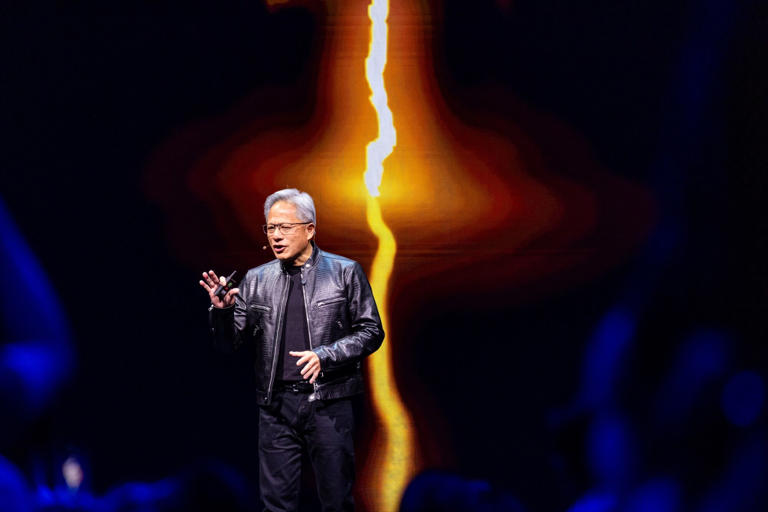Nvidia Rubin AI platform, Nvidia 2026 AI advancements, Blackwell Ultra chip, generative AI, AI in personal computers, Nvidia high-bandwidth memory, Computex 2024, AI technology advancements, Nvidia AI tools, Jensen Huang announcements
Discover Nvidia’s groundbreaking Rubin AI platform set for 2026, as unveiled by CEO Jensen Huang. Learn about the annual AI accelerator upgrades, new tools, and software models aimed at revolutionizing generative AI. Explore Nvidia’s expansion beyond cloud giants and its impact on various industries. Get insights into the upcoming Blackwell Ultra chip, high-bandwidth memory, and the future of AI-enhanced personal computers and server designs.

Nvidia Rubin AI platform Introduction
Nvidia Corp. has made waves once again with the announcement of its next-generation AI platform, Rubin, set to debut in 2026. This news, delivered by CEO Jensen Huang, marks a significant leap in the company’s relentless pursuit of advancing artificial intelligence technology. The announcement was made at the National Taiwan University, just before the Computex trade show in Taiwan, and has set high expectations within the tech community.
Annual AI Accelerator Upgrades
Jensen Huang highlighted Nvidia’s commitment to annual upgrades of its AI accelerators, unveiling plans for the Blackwell Ultra chip in 2025 and the Rubin platform for 2026. This aggressive upgrade schedule aims to keep Nvidia at the forefront of AI technology, catering to the ever-growing demands of data processing and machine learning.
New Tools and Software Models
In addition to hardware advancements, Nvidia introduced new tools and software models to enhance AI capabilities. These innovations are expected to play a crucial role as generative AI evolves into what Huang described as a new industrial revolution. Nvidia’s vision is to transition AI technology from data centers to personal computers, broadening its impact and accessibility.
Expansion Beyond Cloud Giants
Nvidia has been a primary beneficiary of increased AI spending, becoming the world’s most valuable chipmaker. However, the company now seeks to diversify its customer base beyond major cloud-computing firms. Huang envisions a future where a wide array of industries, from shipbuilding to pharmaceuticals, will integrate AI into their operations. He reiterated a message from a previous keynote: entities that fail to adopt AI will inevitably fall behind.
Addressing Computation Inflation
Huang discussed the concept of “computation inflation,” where the exponential growth of data outpaces traditional computing methods. He emphasized that Nvidia’s accelerated computing approach is essential to managing costs and energy consumption. According to Huang, Nvidia’s technology offers 98% cost savings and 97% less energy usage, a claim he humorously termed as “CEO math.”
Rubin AI Platform and HBM4 Memory
The upcoming Rubin AI platform will leverage HBM4, the next iteration of high-bandwidth memory. This memory type has become a critical bottleneck for AI accelerator production, with SK Hynix Inc., a leading supplier, largely sold out through 2025. While detailed specifications for Rubin remain undisclosed, it is clear that Nvidia aims to push the boundaries of AI performance with this new platform.
AI in Personal Computers
Nvidia’s roots in gaming cards for desktop PCs are now advantageous as AI functionalities are being integrated into personal computers. Companies like Microsoft and its hardware partners are showcasing new laptops with AI enhancements under the Copilot+ branding at Computex. While these devices use processors from Nvidia rival Qualcomm Inc., adding Nvidia graphics cards can significantly boost performance and enable new software features.
Tools and Pretrained AI Models
To facilitate the incorporation of advanced AI capabilities in PCs, Nvidia is providing tools and pretrained AI models. These tools can perform complex tasks, such as deciding whether to process data locally or send it to a data center. This flexibility is crucial for maximizing efficiency and performance in AI-driven applications.
New Server Design: MGX Program
Nvidia is also rolling out a new design for server computers, known as the MGX program. This design allows companies like Hewlett Packard Enterprise Co. and Dell Technologies Inc. to bring products to market faster. Even competitors like Advanced Micro Devices Inc. and Intel Corp. are utilizing this design to integrate their processors with Nvidia chips, demonstrating the industry-wide impact of Nvidia’s innovations.
General Availability of Earlier Products
Products announced earlier, such as Spectrum X for networking and Nvidia Inference Microservices (NIM), are now generally available and widely adopted. NIM, described by Huang as “AI in a box,” offers companies a set of intermediate software and models to expedite the deployment of AI services. Nvidia is also providing free access to NIM, with usage fees applied only upon deployment, making it an attractive option for businesses looking to implement AI quickly and efficiently.
The Omniverse and Digital Twins
Huang also highlighted the use of digital twins in Nvidia’s virtual world, the Omniverse. He showcased a digital twin of Earth, called Earth 2, capable of sophisticated weather modeling and other complex simulations. Taiwan-based manufacturers like Foxconn are utilizing these tools to enhance planning and operational efficiency, illustrating the practical applications of digital twin technology.
Conclusion
Nvidia’s announcement of the Rubin AI platform for 2026 signals a bold step forward in AI technology. With a focus on annual upgrades, new tools, and expanding beyond traditional customer bases, Nvidia aims to lead the next phase of the AI revolution. The company’s innovations in high-bandwidth memory, AI-enhanced personal computers, and server design underscore its commitment to advancing AI capabilities across various industries. As generative AI continues to transform the technological landscape, Nvidia’s Rubin platform is poised to play a pivotal role in shaping the future of computing.
Read More-